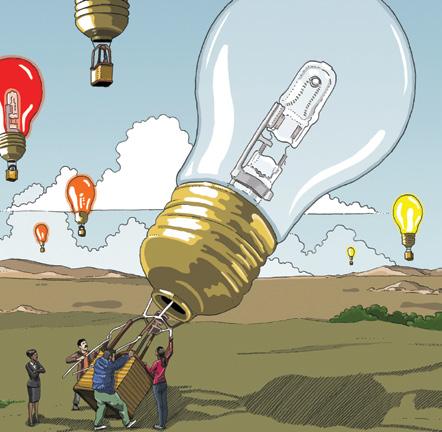
3 minute read
COMMUNICATION
STARTS WITH UNDERSTANDING YOUR AUDIENCE’S DIGITAL USE AND BEHAVIOUR
Like any innovator, civil society organisations have two main levers to drive change: technology and human behaviour. The way we communicate and how we access and process information about the world around us is changing as technology evolves in the 21st century. Those that fail to adapt to innovative new ways of communicating may struggle to keep pace.
Consumer broadband consumption in North America reached a milestone in the fourth quarter of 2021 as averages hit 536.3 gigabytes (GB) per month – surpassing half a terabyte (TB), according to a new study. This figure represents an increase of 165% when compared to the previous average of 203 GB per month.1
Undoubtedly, this figure will be higher today. Back home, a similar picture is emerging. According to a survey of 18 to 26-year-olds in South Africa, young people spend a quarter of the day on their phones.2 This is not hard to believe considering that Internet access using mobile devices is the most common form of access to the Internet (69.4%)3 in this country.
Although the use of mobile devices in rural parts (59.2%) lags urban (73.7%) and metro areas (73.4%), it keeps growing.4
Smartphone proliferation is bringing more people online globally from Soweto to South Carolina. This is having a profound impact on how we access and consume information, and affects our attention spans, memories and cognitive processes.5
So, what does this mean for civil society organisations focused on behaviour change? And what can they learn from other organisations utilising the power of digital technology? This learning brief explores these questions by centring the experience and learnings of the #keready campaign and other DGMT-funded initiatives, such as: Youth Capital, Nal’ibali, the Zero Dropout Campaign and Amplify|Mobilise|Change (AMC).
1 Baumgartner, J. 2022. Average data consumption eclipses half a terabyte per month – OpenVault. LightReading, 3 Jan. https://www.lightreading.com/ cable-tech/average-data-consumption-eclipses-half-terabyte-per-month--openvault/d/d-id/775689
2 Nair, N. 2022. Young South Africans check their phones at least 30 times an hour: survey. Sowetan Live, 10 May. https://www.sowetanlive.co.za/s-mag/ living/2022-05-10-young-south-africans-check-their-cellphones-at-least-30times-an-hour-survey/
3 Statistics South Africa. 2021. General household survey, p. 47. https://www. statssa.gov.za/publications/P0318/P03182021.pdf
4 Ibid.
5 Wolf, M. 2008. Proust and the squid: the story and science of the reading brain. Thriplow: Icon Books.
Follow Your Audience
While many young people use mobile phones to communicate and access information, it must be acknowledged that lots of South Africans struggle with access and connectivity. This learning brief focuses on the use of digital communication, but it must continue to be supported by other forms of communication (such as radio and face-to-face communication) in order to reach as many people as possible.
“Follow your audience” is the basic principle.
CASE STUDY #KEREADY
When the Covid-19 pandemic initially swept across South Africa in early 2020, young people were not the focus of vaccination campaigns as they were not viewed as high risk. However, the key to high vaccination coverage is young people – as a third of the entire population is aged 18–34.6 The #keready campaign emerged out of DGMT’s involvement in establishing a demand acceleration task team in collaboration with other donors and government departments in 2021.
Launched in February 2022, after intense engagement with youth in various parts of the country, #keready harnessed the power of digital communication to put young people in charge of campaign messaging promoting the uptake of Covid-19 vaccinations. At the time, only 5 million of the country’s 17.7 million people aged 18–34 had been fully vaccinated.7 #Keready means “I am ready” in Mzansi8 slang, so it is accessible to all young South Africans, not just township youth. The “I am” has a sense of agency, encouraging inclusion and involvement.
“The campaign is deliberately unbranded so that it is an uncontested space for the youth. It represents the views that young people repeatedly shared: they don’t want to hear from government or from politicians or even from paid influencers about vaccines.”
Lebo Motshegoa, head of communication, #keready
6 DGMT. 2022. #Keready – Young want their lives back! https://dgmt.co.za/ keready-young-people-want-their-lives-back/
7 Kgomotso,
8 Informal name for South Africa from IsiXhosa, literally meaning “south”.
Dr Joe Phaahla, Minister of Health, endorsed the campaign as part of the Health Department’s demand generation efforts: “We were happy to support young people who decided to take the vaccination campaign as their own under the theme #keready, I am ready. The campaign is led by young health professionals and ours [sic] is simply to support and encourage, they are in charge of the campaign.”9
An independent evaluation report by Genesis Analytics found that vaccination uptake in 12 to 19-year-olds was significantly larger than would have been expected without the #keready campaign, with an estimated 251 000 more vaccinations administered as a result of the intervention.10
The campaign has since evolved into a movement that seeks to enhance healthcare-seeking behaviour among young people. #Keready aimed to put young people in control of the message, creating incentives for their participation in vaccination programmes and public health activities, as well as offering unfiltered health information.
10








